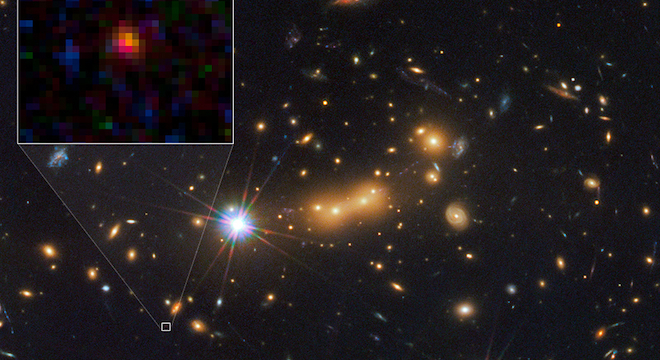The most ancient and distant galaxy yet observed — the light from which traveled 13.3 billion years to reach Earth — has been pinpointed by scientists taking an unprecedentedly deep look through the Hubble Space Telescope, NASA announced on Thursday.
The galaxy, named MACS0647-JD, is tiny by comparison to most of the galaxies we’re more familiar with, including our own Milky Way.
“It’s less than a percent of the Milky Way in terms of its diameter and its mass,” said Dan Coe, the astronomer at the multi-institution Space Telescope Science Institute, who first discovered the galaxy back in February 2012, in a phone interview with TPM on Thursday.
In fact, as NASA notes in its press release on the news, MACS0647-JD is just 600 light years wide, while the Milky Way is 150,000 light years across. The ancient galaxy is small even by the standards of other dwarf galaxies, which are typically on the order of 2,000 light years across.
The ancient galaxy appears to have been spawned just 420 million years after the Big Bang is theorized to have occurred or earlier, an incredibly short period in cosmic time.
It’s also “clumpier” than the Milky Way’s elegant spiral shape or even the shape of elliptical galaxies, such as the M87 cluster.
“It basically looks like one really bright clump,” Coe told TPM. “Galaxies back then were much more disordered.”
Here’s a video from NASA and the European Space Agency (ESA) illustrating where the galaxy was found in the sky:
But now that some 13.3 billion years have passed since the galaxy looked like it does to Hubble, it likely has grown and filled out with more stars, and may even be comparable in size to the Milky Way, and perhaps there’s an Earthlike planet supporting life.
“If anything its gotten bigger,” Coe said of the galaxy. “They could’ve had similar course [as the Milky Way], they could’ve evolved and be looking back at us through their telescopes.”
After sighting the galaxy in February, it took Coe and other scientists the next 10 months to rule out other explanations for what the object might be.
But it was a lucky find to begin with, as Coe admits. “Maybe a bit too lucky,” Coe said.
That’s because the galaxy’s light is just on the edge of what Hubble is capable of picking up, on the high-end of the redshift, the longer wavelengths of light that occur as photons travel across the vast distances of the universe, and are undetectable to the human eye and even many of our telescopes.
“Ultraviolet light from the hot, young stars in that distant galaxy now appears infrared to us, too red for our eyes to see and almost too red for Hubble!” Coe wrote on the Space Telescope Science Institute website.
In fact, the only way that Hubble was able to spot the object in the first place was through a special program called Cluster Lensing And Supernova Survey with Hubble (CLASH) — which relies on the gravitational effects of closer, more massive galaxy clusters to magnify the light from their more distant, and ancient counterparts. Specifically, in this case, the CLASH program used light from the massive galaxy cluster MACS J0647+7015 to magnify the light of the most ancient galaxy.
As NASA explained in its press release: “The cluster’s gravity boosted the light from the faraway galaxy, making the images appear about eight, seven, and two times brighter than they otherwise would that enabled astronomers to detect the galaxy more efficiently and with greater confidence. ”
Still, even with gravitational lensing, it took Hubble’s use of 17 different wavelength filters in order to locate the galaxy, and the galaxy only showed up in the two reddest filters. The CLASH team also relied on two filters from the further-out Spitzer Space Telescope, a Sun-orbiting (heliocentric) infrared telescope designed specifically to peer into the origins of the Universe.
“Once we know how bright the object is in each of these 19 wavelength ranges, we can construct an approximation of its spectrum — and that then gives us the distance,” explained Marc Postman, who leads the CLASH team, in an email to TPM. “The uncertainty in this distance estimate is about 5%, which is really good for a distance derived in this way.”
But because the object is just barely within the reach of our current technology, we don’t know very much about it beyond its age, its size and its shape. Still, Coe and Postman are hopeful that further studies with the Spitzer telescope and the upcoming James Webb Space Telescope, Hubble’s successor, will be able to reveal more about this ancient galaxy and locate other, even older ones.
“If we took deeper Spitzer images… that could tell us how much earlier galaxies were really forming,” Coe told TPM. “We think the content of the dust in the galaxies was more pristine back then. It wasn’t as rich or polluted from supernovas and the star stuff we ended up being created out of.”
“Next steps would be to try to get deeper Spitzer data to better measure it’s age, star formation rate, and mass,” Postman added. “Then eventually use JWST[James Webb Space Telescope] to get a spectrum to learn more about its composition and possibly its internal structure.”
Despite the lack of a clear picture of what looks to be the most ancient object yet discovered in the universe, Coe was willing to speculate to TPM what a hypothetical observer on a planet in the galaxy might see from their night sky vantage point (although its worth keeping in mind that the galaxy was likely far too young for planets to have formed at that period).
“The sky would be ablaze with more, brighter stars.” Coe said. “It would be denser with stars, too. You wouldn’t see a band like the Milky Way, they’d be spread all over the sky. The star your planet was around would likely be a binary (two star) system.”






